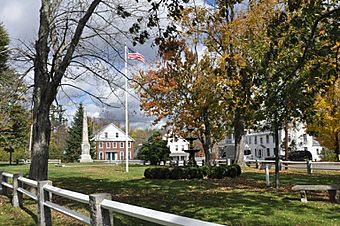Fitzwilliam Common Historic District facts for kids
Quick facts for kids |
|
|
Fitzwilliam Common Historic District
|
|
 |
|
| Lua error in Module:Location_map at line 420: attempt to index field 'wikibase' (a nil value). | |
| Location | Jct. of NH 119, Richmond Rd., and Templeton Hwy., Fitzwilliam, New Hampshire |
|---|---|
| Area | 13 acres (5.3 ha) |
| Architectural style | Greek Revival, Federal, Italianate |
| NRHP reference No. | 97000399 |
| Added to NRHP | May 2, 1997 |
The Fitzwilliam Common Historic District is a special area in the small town of Fitzwilliam, New Hampshire. It's like a time capsule, showing how the town looked long ago. This district covers about 13 acres, which is about the size of 10 football fields! It includes the town common, which was first laid out in 1765. The buildings around the common are also part of this historic area. This district was added to the National Register of Historic Places in 1997. This means it's recognized as an important place to protect because of its history.
Contents
Exploring Fitzwilliam's History
The land that is now Fitzwilliam was first given out in 1752. However, people did not start settling there until 1765. This was because of conflicts with Native American groups in the area. These conflicts lasted until after the French and Indian War.
How the Town Center Grew
The center of Fitzwilliam became a busy place in the early 1800s. This was because many turnpikes crossed there. A turnpike was a special road where you paid a toll to use it. Many of the buildings you see around the common today were built during this time.
Discovering Old Building Styles
Most of the buildings around the common show two main styles of architecture. These are the Federal style and the Greek Revival style.
Federal Style Buildings
The Federal style was popular in the United States from about 1780 to 1830. Buildings in this style often look simple and elegant. They might have flat fronts and balanced windows.
Greek Revival Style Buildings
The Greek Revival style became popular a bit later, from about 1825 to 1860. These buildings often look like ancient Greek temples. They might have tall columns and grand entrances. For example, the Connelly House was built around 1795. But in the 1830s, it was updated with Greek Revival features.
Italianate Style Buildings
There are only two buildings in the district with a later style called Italianate. This style was popular in the mid-1800s. Italianate buildings often have low-pitched roofs and tall, narrow windows. They might also have decorative brackets under the eaves. The Henry House, built around 1870, is one example. The Fitzwilliam Community Church, built in 1857, is the other.
Important Buildings to See
Many important buildings stand around the Fitzwilliam Common. They tell stories of the town's past.
Public Buildings
- The Town Hall was built in 1817. It is so important that it is also listed separately on the National Register of Historic Places.
- The Public Library started as a private home in 1804. The town bought it in 1912 to use as a library.
- An early Fire Engine House was built around 1827. This is where the town's first fire engines were kept.
Commercial Buildings
- The Fitzwilliam Inn was built in 1843. Inns were places where travelers could stay and eat.
- The Fitzwilliam Market opened in 1859. This was likely a place where people bought food and other goods.

